1.
15 million years ago a roughly circular plot of land in Borneo, about 390 square kilometers in size and 25 kilometers wide, was pushed more than a kilometer above it's surroundings. Shortly (at least in geological terms) thereafter, the middle and southern parts of the circle began to collapse, creating a network of ridges and valleys all of which drained via one river. The Maliau Basin had formed and was cut off from the rest of Borneo.
Fast forward to 1947. A bush pilot rediscovers the basin when he almost crashes into its outer escarpment (1676m above sea level). According to the map, it shouldn't be there.
In the 1960's a geological team makes it to the edge of the basin but does not enter. It becomes evident that no one has ever lived there; there are no forest-dwelling natives.
In 1976 the first attempt to ascend the rim takes place. It ends in failure after many of the team catch Malaria. In 1982 the first successful reconnaissance into the basin takes place. It's very likely that no human had ever been there before that.
This is followed by four people entering in 1986 in preparation for the first scientific expedition that takes place in 1988. Maliau Basin has now been explored-however, to this day there are parts that have not yet been visited and mapped.
Fortunately, the Malaysian government realized that they were onto something unique and the whole area is a conservation zone. This is especially commendable given the quality of the timber and the estimated 200 million tinned of coal that may sit below it.
2.
Since the basin has been so cut off from the rest of the world it has developed some it's own species. In fact, it has its own fish, water beetle, crab, moss and tree.
And it's the trees of Maliau Basin that really clue you in to how remote it is.
Before you enter the basin you do a canopy walk (oddly enough sponsored by IKEA). This was quite different from other canopy walks I had done as the trees were all four to six feet wide and you were easily 60 feet off the ground-and nowhere near the top of the tree.

We spent the first night of the hike at the Camel Trophy camp where they have a 'treehouse' built almost 120 feet above the ground (Don't worry, you don sleep in the treehouse).

Climbing up to it is terrifying. As you stand at the bottom of the ladder it seems to recede to infinity and be buckling under it's own weight.
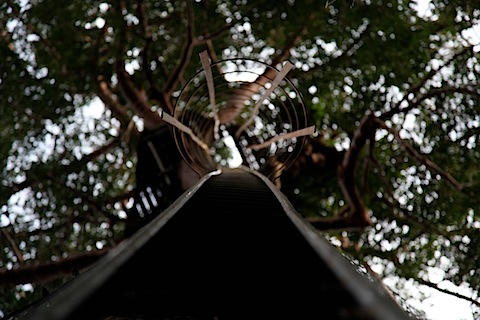
As I climbed it I noticed a spider on the bark, staring at me with its fangs on the defensive. Fortunately, it didn't know how to jump and I defused the tension by climbing away.
A few more comments on the trees.
As you walk through the park you notice how very dark it is and then you realize that all the trees around you are at least 100 feet tall. Sometimes they trees that grow straight up with almost no roots, other times a mature strangler dig who has completely eroded the host and other times buttressed with roots up to 25 feet long and 10 feet tall.

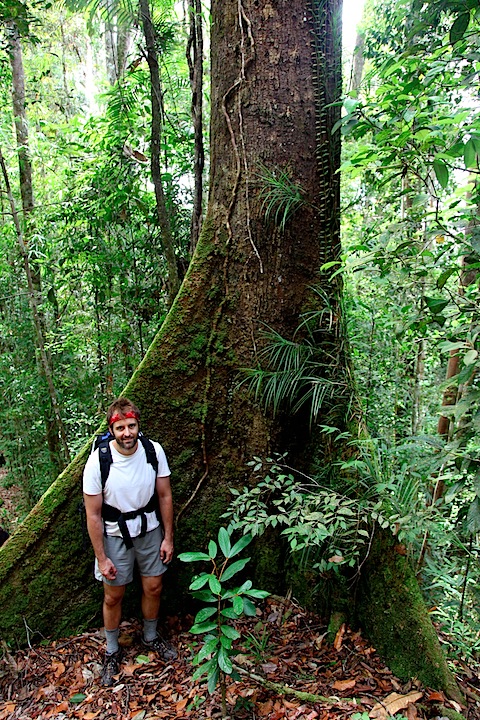
The night before we entered the park we went for a 'night ride'. This mean riding in the bak of a slow moving 4x4 while the guide paints the trees with a spotlight in search of wildlife. When you see the forest one tree at a time while it is simultaneously silhouetted against the full moon, you get a true sense of just how massive it is.
3.
One of the reasons we did the night ride is that Maliau Basin is a pretty good place to see wildlife. On our way into the park we saw this Buntang (water buffalo) and it's mother:

Moron that I am, I thought a local farmer had lost his cow (this despite not seeing a farm for miles).
On the night ride we saw a jungle deer (doesn't 'jungle deer' sound so much fancier than just 'deer' even though they're the same thing?) and numerous flying squirrels. Our guide made one jump by flashing the light at it. Another one jumped before he could get a light on it; as it soared, it was like a wedge of darkness silently soaring above the rainforest. It would be very freaky to run into one.
When we stayed at the Camel Trophy camp we had a nighttime visit from the local civet. Two shiny eyes emerged from the darkness to reveal a black and white striped throat and then a spotted body and black tail. He looked like could eat a domestic cat.
When we hiked from that camp to Maliau Falls we saw quite a few monkeys. In my mind I've the frozen image of a gibbon jumping between trees. He has his right arm raised behind him; seconds prior it had been holding a branch. He's staring ahead as he casually jumps to the next branch; he hasn't even extended his left hand to catch himself.
On the return leg of that hike we startled a few red leaf monkeys who had been collecting fruit on the ground. At the sight of us, the began scurrying up the trees, hand over hand, all the while keeping their eyes on us. They then jumped from tree to tree to flee us, calling back and forth to one another as we walked along the trail.
4.
The one creature we saw far too many of was the forest leech. These little bastards are everywhere:
They crawl all over your shoes and you are constantly flicking them off. Sometimes they stick to your finger mid flick and then you're forced to distract them by rolling them in a ball before depositing them elsewhere. I took great pleasure in using my blood-filled finger to lure them onto leaves and then tossing the leaves as far into the forest.
Despite my vigilance, two still got me. I got into the shower and discovered that one had crawled into my shorts and feasted. He must have hid on my bag's waist straps; I never heard or felt him.
Another used a lull in my flicking to nestle into the hollow between my ankle and heel. Only when I took my sock off did I find the little parasite.
Fortunately they cause no pain.
5.
The leeches live in the lowlands, but quite a bit of your time is spent in the mossy Heath forest that starts around 1,000 meters above sea level.
There, the trees are skinnier, shorter and the forest denser. The bottom three feet of each tree I covered in moss and nepenthes, better know as pitcher plants. They come in a variety of collies and sizes. Sometimes they appear by themselves and other times in clumps.


6.
The pitcher plants are beautiful, bit they're not the ultimate destination on your hike. You're hiking to waterfalls.
The geography of the basin is such that this area has the highest concentration of waterfalls in Malaysia. On our first day we hiked to Giluk Falls.
You approach it from above and can stand right beside it, getting vertigo and a sense of how far it drops.
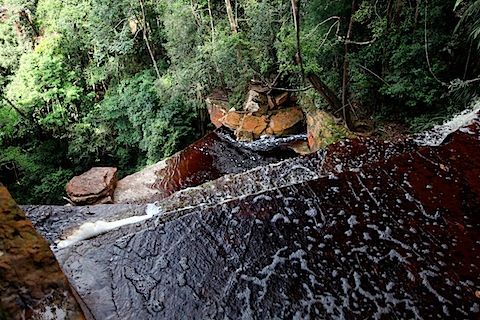

Afterwards, you can climb a plateau and see a set of fall that feed into it. Note that the 'soap' is not pollution, it's caused by a chemical in the plants.

Maliau Falls is the biggest waterfall in the basin. You arrive there and realize that you're standing next to a 28 meter cliff with a second set of falls on it.
The falls themselves are beautiful, although the water is a bit stained due to the tannins in the soil. Our accompanying ranger wouldn't let us swim (despite a schizophrenic sign that said: "No Swimming. Swim at your own risk") otherwise I would have loved to swim up to the base of the falls.
- So, the hiking itself. It's tough.
The distances aren't far (the longest day is 15km) and the elevation isn't too much (maximum daily climb is about 500 meters) but the trail is rough. Every day in the forest feels like fall as you're walking over piles of (leech-infested) leaves. That are hiding mud underneath.
They don't get too many people in the basin (I think our group of eight had it to ourselves for four days) so the trails aren't maintained. We were accompanied by a ranger who spent a lot of time clearing brush from the trails.
There are many bridges that consist just of logs and look like they came from a rummage sale at the Indiana Jones film lot.


Since it's the jungle, everything is wet and rotting and aging fast. I had one rung of a ladder give out as I was hiking, sending me for a short spill. Another time I could hear individual branches snapping as I crossed a bridge.
Part of the joy of hiking the park is descending the web of ridges that crisscross the park. You can walk along a ten foot wide ridge and see palm forest on one side, deciduous trees on the other. Alas, they all come to an end and then you have to climb down a steep, windy, muddy limestone path to your next section of trail.

The trails are also oddly blazed. The trail markers count distance up, not down, and are of questionable accuracy. Most glaring is the one that states "500 meters to Ginseng camp".
As I passed this and ten minutes later found myself crossing a river after having scrambled down a near-cliff and a switchbacked muddy trail, all the while in pounding rain and pre-thunderstorm darkness, I found myself cursing the inability of Malaysian trailblazers to properly articulate distance.
The challenge of hiking is compounded by the heat and humidity. Everything is always wet and after 7 am it's always hot. To give you an idea of how humid it is, when we stepped out of the rainforest onto a hilltop clearing, we couldn't take photos as our camera fogged up-inside the lens! You sweat continuously.

It's not the hardest hiking I've done, but it can be unpleasant at times (although a few years ago a 72 year old woman did it).
8.
In order to make the hike a little easier, the folks at Borneo Nature Tours and the park conservancy set you up with quite a few people.
You are accompanied by a forest ranger. There's a guide. And at each camp (which are permanent buildings, no tents for you), you're cooked a meal by two guys whose existence is to truck food from campsite to campsite.
Our ranger was amazing. He pointed out innumerable hidden jungle charms. Countless different types of fungi and insects. He would playfully call out to screaming monkeys. He found birds eggs lodged in a rotting stump. And he'd pick jungle fruits and pass them on to us.

Our 'guide' on the other hand was something else. On the first day it became clear that his fitness level left something to be desired as he struggled up the hill almost ten minutes behind the group.
On the second day he did not force people to drink or bring enough water. One guy in our party got heatstroke. The entire group ran out of water.
The kicker was that when we got to camp, I had to go get water for everyone; he was just hanging out like nothing was wrong.
I could go on and on about his woeful guiding abilities (e.g., telling people he didn't know where the trail was, answering distance-related questions with platitudes like "not far", not having a first aid kit, etc.) but then you might get the impression that I didn't have fun. But I actually had a lot of fun; our guide was just a complete and utter clown.
9.
While the Malaysian government has done a great job of protecting Maliau Basin, the road up is basically one long palm plantation. It's frankly scary how much rainforest has been cut down to plant only palms. You get the feeling that they're one new disease away from a wasteland.
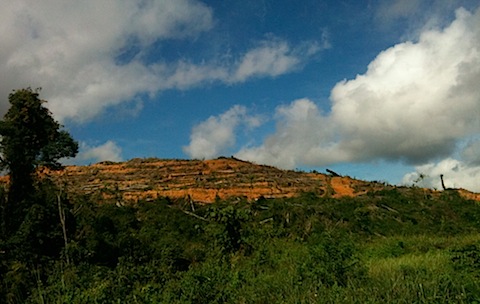
10.
As with Mulu park, we found ourselves surrounded by weird bugs and fungi:







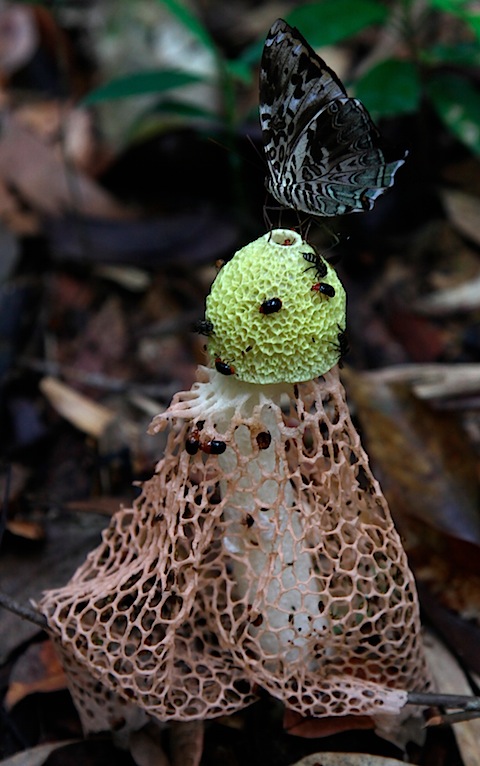
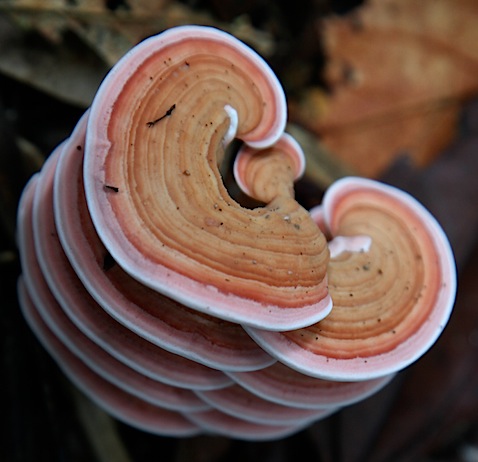
11.
One of the cooks at Maliau Basin wanted to practice his English with me. He was from a small country village in the foothills of Mt. Kinabalu; he'd gone to Maliau Basin in search of a job.
We had a great conversation (albeit slowly) about life in Canada vs. life in Sabah (the region of Borneo where Maliau Basin is). He couldn't believe that it got so cold in Canada and was shocked that we eat so much cheese - but glad to hear that the Bornean bananas are better than Canadian bananas.
He also asked me how I met Wendy and warned me to watch out for girls in Semporna - and that Wendy would be watching me when I was in Semporna. I told him I'd wear sunglasses in Semporna and he thought that was the funniest thing he'd ever heard.